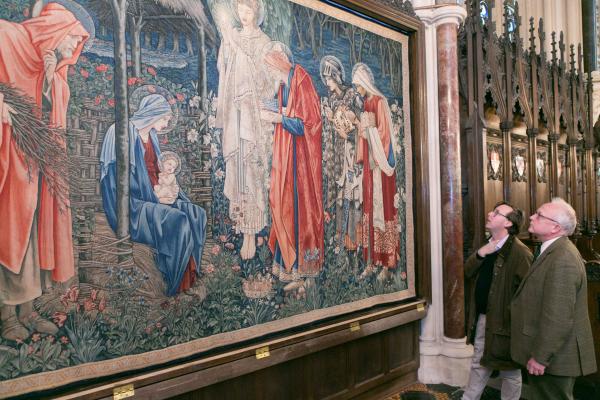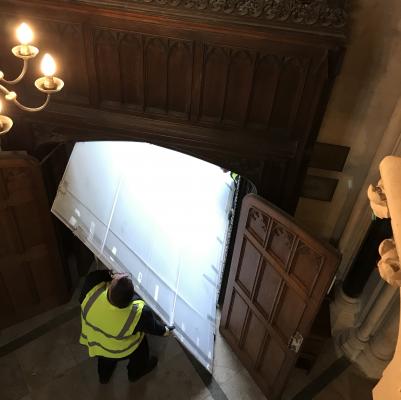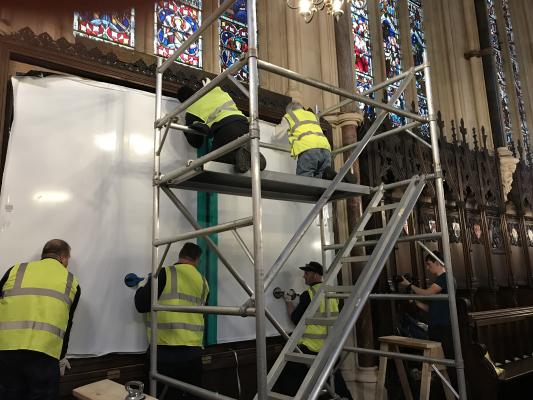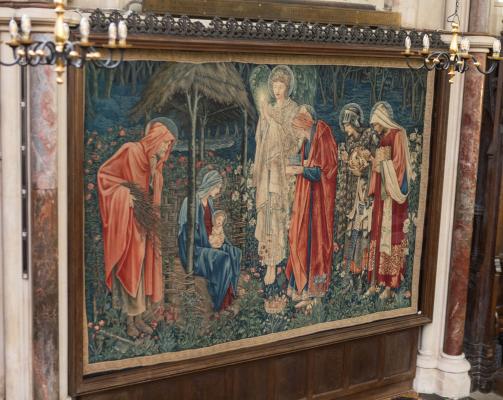Re-Framing of "Adoration of the Magi" Tapestry in Exeter College Chapel
By on 25th Mar 2019
For over six years, the Bursar at Oxford’s Exeter College, William Jensen, had been looking for a practical and affordable solution to re-glaze Adoration of the Magi, a tapestry hanging in their chapel. Challenges included the size of the tapestry (2.4m x 3.6m / 7 ft 10 in x 11 ft 10 in), the limited size of the exterior chapel doors through which the glazing would have to pass, and the existing frame design that was fixed to the wall. As an authorized Tru Vue distributor in the United Kingdom (UK), we were approached to work on the project last fall, and a solution was soon realized. David Palmer, our Glazing Consultant at Wessex Pictures, thought it would be a brilliant use of the seamed version of Optium Museum Acrylic®. Available in sizes up to 3m x 8m (10 ft x 26 ft), seamed Optium provides a glazing solution to protect works larger than the maximum single sheet size – approximately 3m x 1.8m (10 ft x 6 ft).
Accessibility Controls
The player supports TAB to change the controls.
Update Required<br/>To play the media you will need to either update your browser to a recent version or update your <a href='http://get.adobe.com/flashplayer/' target='_blank'>Flash plugin</a>.
The Re-glazing project
The project to re-glaze the tapestry was overseen by professional conservators Georgie Dennis of Georgie Dennis Conservation, and Jonathan Tetley of the Tetley Workshop. “The actual tapestry is in fantastic condition, so the main work we were involved in was surface cleaning, to remove loose dirt and particulate soiling, and then to reline it because the lining had been in place for a number of years and was soiled, and needed to be refreshed and replaced,” describes Sarah Howard, ACR, Contract Conservator at Tetley Workshop.
Dennis described how the main conservation concerns for the work were light damage and protecting it from the environment, including dust, insects, humidity and temperature. According to Dennis, “The biggest challenge was the size, and finding the right [glazing] material. Glass was too heavy and actually could only be manufactured in one sheet, which was too large to get in [the chapel]”.

(The chaplain and the bursar admire the tapestry in the frame prior to installation of the glazing. Image: Studio8 Ltd)
The glazing for the fixed wall frame measured 3.6m x 2.5m (11 ft 10 in x 8 ft). “When we discussed the re-glazing of the tapestry with College authorities, we came down to two choices. One was to use seamed 6mm [thick] Optium and the other, a single piece of 10mm low reflectance laminated glass. It was really virtually impractical to position that [size] piece of glass into the frame and come through the doors because it would have weighed way over 150 kg (330 lbs.); we would have had to of used robotic lifts and to get those through the doors would have been extremely problematic,” Palmer explained. “We can obtain exactly the same result by using the Optium, with a lot less weight”. Giulia Bertolotti, International Museum and Conservation Liaison for Tru Vue, adds, “Indeed, compared to glass, [Optium] is roughly half the weight and so it makes the use of the original frame possible”.
We handled the logistics of ordering, packing, and shipping the joined sheet from the USA, as well as the installation of the sheet in the chapel at Exeter College. “In order to get the sheet to arrive here in good condition . . . we modified the standard packing by using fluted polycarbonate sheeting on both sides of the package because it was a single sheet being shipped by air from Boston into London, and then [transported] to our warehouse,” Palmer explained.

(Unloading Optium Museum Acrylic from our truck on to a special A-frame. Image: Studio8 Ltd)
Palmer further elaborates: “Getting it up here we made a special A-frame to go on to our truck . . . it was just a question of maneuvering [the acrylic] through the exterior doors of the chapel as they were slightly smaller than the height of the sheet . . . that was a bit of a challenge, but everything worked out very well”.

(The Optium Museum Acrylic sheet is carefully manoeuvred through the exterior doors into the chapel.)
Installation
Using the original frame for the tapestry was important, but posed several challenges. The frame is fixed to the wall of the chapel, and needed to be adapted from its original design, which held 10mm laminated glass, to accommodate the seamed Optium which is 6mm thick. “We [had] to load the glazing from the front, rather than dropping it into frame as we would normally do…So we had to study and then come up with a procedure, which we followed pretty accurately, to ensure that it went into the frame without too much problem,” says Palmer. To deal with the difference in glazing thickness, we manufactured a slip to pack out the frame.

(Installation of Optium Museum Acrylic into the fixed wall frame.)
The Importance of Protective Presentation
Conservation framing was central to the project. “Good conservation framing really helps toward preservation of the object. It prolongs the period the object can just sit on display without further intervention from conservators,” explains Anne Kvitvang, Contract Conservator at Tetley Workshop. Dennis explains further the importance of framing decisions in the success of a conservation project, “Framing can really make or break a work, both in terms of the aesthetics in how it looks and appears to the viewer, but also in terms of conservation in preserving it for the future. Seamed Optium is really a fantastic solution in that it protects the work; it filters UV out, which is one of the main damaging factors. It is incredibly clear; it doesn’t reflect the light so it’s almost as if it’s not there, which is ultimately what you are trying to achieve.”
Bertolotti explains how the situation of the tapestry in an active chapel makes glazing an important requirement, “Optium Museum Acrylic will protect the artwork from UV, from dust, from touching and from other types of risks which are associated with the presence of the public, and the use of the space in which the tapestry is displayed. The protection is given without any risk for any component of the artwork to be attracted to the surface of the glazing, because Optium is anti-static”.
Viewing
Now that the conservation and re-glazing are complete, a significant difference can be seen in the tapestry’s appearance. “I think the tapestry is looking really, really fantastic…it is such an obvious change between how it looked before and how it looks now. The colours are so much more vivid, the lines are so much clearer,” praises Beatrice Alabaster, B.A. Student in English Language and Literature at Exeter College.

(Close up of the re-framed “Adoration of the Magi” in situ. Image: Studio8 Ltd.)
Reverend Andrew Allen, Chaplain and Exeter college fellow shares this appreciation as well. “This tapestry is in some ways a crescendo of an artistic movement trying to understand God, and nature and God in good craftsmanship. So I think it is vitally important that today we are still working in that spirit, by making sure that we have the best way of conserving it, and using it so that first both ourselves and future generations can relish in this tapestry and perhaps get a glimpse of something beyond our everyday life.”
